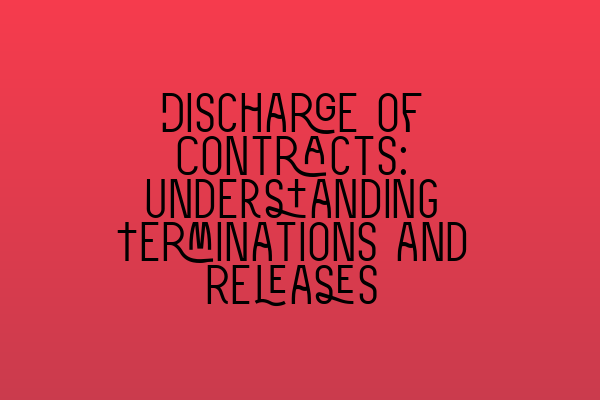Discharge of Contracts: Understanding Terminations and Releases
Contracts play a vital role in our day-to-day lives, governing business transactions, employment relationships, and more. However, there are circumstances where a contract may need to be terminated and released. In this blog post, we will delve into the concept of contract discharge, exploring the different methods by which a contract can be terminated and released.
What is Contract Discharge?
Contract discharge refers to the termination of a contract, freeing the parties involved from their obligations and releasing them from any further legal liabilities. There are several ways in which a contract can be discharged, and understanding these methods is essential for anyone navigating the complex world of contract law.
Methods of Contract Discharge
1. Performance
The most straightforward method of contract discharge occurs when both parties have fulfilled their contractual obligations. This is known as performance, and it results in the automatic termination of the contract. When a contract is performed, all rights and obligations under that contract are extinguished.
For example, imagine a scenario where Party A hires Party B to paint their house. Once Party B completes the painting job to Party A’s satisfaction and Party A pays the agreed-upon amount, the contract is discharged through performance.
2. Agreement
Another common method of contract discharge is by agreement. This occurs when the parties mutually agree to terminate the contract, often due to a change in circumstances or a desire to restructure their contractual relationship.
It is crucial to ensure that the agreement to terminate is clear and unambiguous. This can be achieved by drafting a separate contract termination agreement or by including a termination clause in the original contract. Such a clause typically outlines the conditions and process for terminating the contract.
For instance, Party A and Party B may enter into a contract for Party A to supply goods to Party B. If both parties agree to terminate the contract due to Party A’s financial difficulties, they can draft a termination agreement that clearly outlines the terms and conditions of termination. This agreement would legally discharge the original contract.
3. Breach
When one party fails to fulfill their contractual obligations, it constitutes a breach of contract. A breach provides the non-breaching party with the option to terminate the contract and seek legal remedies for the damages suffered.
There are two types of breach: anticipatory breach and actual breach. Anticipatory breach occurs when a party indicates, before the time for performance, that they will not fulfill their obligations. In contrast, actual breach refers to a failure to perform as agreed at the specified time.
If a breach occurs, the non-breaching party may choose to terminate the contract, rendering it discharged. However, it is advisable to consult with legal professionals to evaluate the best course of action, as the consequences of termination can vary depending on the circumstances.
4. Frustration
Contracts can also be discharged due to frustration, which arises when unforeseen events occur, making it impossible or radically different to fulfill the contract. Frustration is a legal doctrine that allows contracts to be terminated when the circumstances make the contract impossible to perform.
For instance, let’s say Party A hires Party B to perform at a music concert. However, due to unforeseen circumstances like illness or force majeure, Party B becomes unable to perform. In such cases, the contract may be discharged by frustration.
Contract Release
In addition to contract discharge, it is important to understand the concept of contract release. Contract release occurs when one party voluntarily releases the other party from their obligations under the contract. This can often occur as part of a mutual agreement to terminate the contract.
Contract release can be formalized through a written agreement between the parties, explicitly stating that one party is released from their duties and responsibilities. This relieves the released party from any further liability and prevents potential disputes in the future.
Conclusion
Discharging a contract is an important process that involves terminating the obligations and liabilities under the contract. The primary methods of contract discharge include performance, agreement, breach, and frustration. Additionally, contract release may occur in cases where one party voluntarily releases the other party from their obligations.
Understanding contract discharge and release is crucial for anyone involved in business transactions or dealing with contractual relationships. It ensures that parties are aware of their rights and obligations, and it helps prevent potential disputes or legal complications down the line.
For more information and resources related to contract law and preparation for SQE exams, you can check out our related articles:
